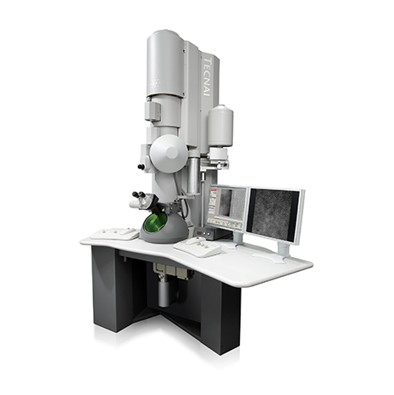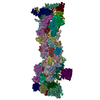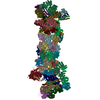[English] 日本語
 Yorodumi
Yorodumi- EMDB-2035: 8.4 A single-particle reconstruction of the 26S Proteasome from S... -
+ Open data
Open data
- Basic information
Basic information
| Entry | Database: EMDB / ID: EMD-2035 | |||||||||
|---|---|---|---|---|---|---|---|---|---|---|
| Title | 8.4 A single-particle reconstruction of the 26S Proteasome from Schizosaccharomyces pombe | |||||||||
 Map data Map data | This is an image of a surface rendered S.pombe 26S proteasome | |||||||||
 Sample Sample |
| |||||||||
 Keywords Keywords | 26S proteasome / AAA-ATPase / PCI-domain / solenoid | |||||||||
| Biological species |  | |||||||||
| Method | single particle reconstruction / cryo EM / Resolution: 8.4 Å | |||||||||
 Authors Authors | Bohn S / Beck F / Lasker K / Forster F / Walzthoeni T / Villa E / Unverdorben P / Aebersold R / Sali A / Baumeister W | |||||||||
 Citation Citation |  Journal: Proc Natl Acad Sci U S A / Year: 2012 Journal: Proc Natl Acad Sci U S A / Year: 2012Title: Molecular architecture of the 26S proteasome holocomplex determined by an integrative approach. Authors: Keren Lasker / Friedrich Förster / Stefan Bohn / Thomas Walzthoeni / Elizabeth Villa / Pia Unverdorben / Florian Beck / Ruedi Aebersold / Andrej Sali / Wolfgang Baumeister /  Abstract: The 26S proteasome is at the executive end of the ubiquitin-proteasome pathway for the controlled degradation of intracellular proteins. While the structure of its 20S core particle (CP) has been ...The 26S proteasome is at the executive end of the ubiquitin-proteasome pathway for the controlled degradation of intracellular proteins. While the structure of its 20S core particle (CP) has been determined by X-ray crystallography, the structure of the 19S regulatory particle (RP), which recruits substrates, unfolds them, and translocates them to the CP for degradation, has remained elusive. Here, we describe the molecular architecture of the 26S holocomplex determined by an integrative approach based on data from cryoelectron microscopy, X-ray crystallography, residue-specific chemical cross-linking, and several proteomics techniques. The "lid" of the RP (consisting of Rpn3/5/6/7/8/9/11/12) is organized in a modular fashion. Rpn3/5/6/7/9/12 form a horseshoe-shaped heterohexamer, which connects to the CP and roofs the AAA-ATPase module, positioning the Rpn8/Rpn11 heterodimer close to its mouth. Rpn2 is rigid, supporting the lid, while Rpn1 is conformationally variable, positioned at the periphery of the ATPase ring. The ubiquitin receptors Rpn10 and Rpn13 are located in the distal part of the RP, indicating that they were recruited to the complex late in its evolution. The modular structure of the 26S proteasome provides insights into the sequence of events prior to the degradation of ubiquitylated substrates. | |||||||||
| History |
|
- Structure visualization
Structure visualization
| Movie |
 Movie viewer Movie viewer |
|---|---|
| Structure viewer | EM map:  SurfView SurfView Molmil Molmil Jmol/JSmol Jmol/JSmol |
| Supplemental images |
- Downloads & links
Downloads & links
-EMDB archive
| Map data |  emd_2035.map.gz emd_2035.map.gz | 4.7 MB |  EMDB map data format EMDB map data format | |
|---|---|---|---|---|
| Header (meta data) |  emd-2035-v30.xml emd-2035-v30.xml emd-2035.xml emd-2035.xml | 9.3 KB 9.3 KB | Display Display |  EMDB header EMDB header |
| Images |  emdb2035_26S_proteasome.png emdb2035_26S_proteasome.png | 1 MB | ||
| Masks |  emd_2035_msk_1.map emd_2035_msk_1.map | 64 MB |  Mask map Mask map | |
| Archive directory |  http://ftp.pdbj.org/pub/emdb/structures/EMD-2035 http://ftp.pdbj.org/pub/emdb/structures/EMD-2035 ftp://ftp.pdbj.org/pub/emdb/structures/EMD-2035 ftp://ftp.pdbj.org/pub/emdb/structures/EMD-2035 | HTTPS FTP |
-Related structure data
| Similar structure data |
|---|
- Links
Links
| EMDB pages |  EMDB (EBI/PDBe) / EMDB (EBI/PDBe) /  EMDataResource EMDataResource |
|---|
- Map
Map
| File |  Download / File: emd_2035.map.gz / Format: CCP4 / Size: 62.5 MB / Type: IMAGE STORED AS FLOATING POINT NUMBER (4 BYTES) Download / File: emd_2035.map.gz / Format: CCP4 / Size: 62.5 MB / Type: IMAGE STORED AS FLOATING POINT NUMBER (4 BYTES) | ||||||||||||||||||||||||||||||||||||||||||||||||||||||||||||||||||||
|---|---|---|---|---|---|---|---|---|---|---|---|---|---|---|---|---|---|---|---|---|---|---|---|---|---|---|---|---|---|---|---|---|---|---|---|---|---|---|---|---|---|---|---|---|---|---|---|---|---|---|---|---|---|---|---|---|---|---|---|---|---|---|---|---|---|---|---|---|---|
| Annotation | This is an image of a surface rendered S.pombe 26S proteasome | ||||||||||||||||||||||||||||||||||||||||||||||||||||||||||||||||||||
| Projections & slices | Image control
Images are generated by Spider. | ||||||||||||||||||||||||||||||||||||||||||||||||||||||||||||||||||||
| Voxel size | X=Y=Z: 2.22 Å | ||||||||||||||||||||||||||||||||||||||||||||||||||||||||||||||||||||
| Density |
| ||||||||||||||||||||||||||||||||||||||||||||||||||||||||||||||||||||
| Symmetry | Space group: 1 | ||||||||||||||||||||||||||||||||||||||||||||||||||||||||||||||||||||
| Details | EMDB XML:
CCP4 map header:
| ||||||||||||||||||||||||||||||||||||||||||||||||||||||||||||||||||||
-Supplemental data
-Segmentation: This is a binary mask of the 26S proteasome
| Annotation | This is a binary mask of the 26S proteasome | ||||||||||||
|---|---|---|---|---|---|---|---|---|---|---|---|---|---|
| File |  emd_2035_msk_1.map emd_2035_msk_1.map | ||||||||||||
| Projections & Slices |
| ||||||||||||
| Density Histograms |
- Sample components
Sample components
-Entire : 26S proteasomes purified from S.pombe cells
| Entire | Name: 26S proteasomes purified from S.pombe cells |
|---|---|
| Components |
|
-Supramolecule #1000: 26S proteasomes purified from S.pombe cells
| Supramolecule | Name: 26S proteasomes purified from S.pombe cells / type: sample / ID: 1000 / Details: The sample was monodisperse / Number unique components: 1 |
|---|---|
| Molecular weight | Experimental: 2.5 MDa / Theoretical: 2.5 MDa |
-Supramolecule #1: 26S proteasome
| Supramolecule | Name: 26S proteasome / type: organelle_or_cellular_component / ID: 1 / Name.synonym: 26S proteasome / Recombinant expression: No |
|---|---|
| Source (natural) | Organism:  |
-Experimental details
-Structure determination
| Method | cryo EM |
|---|---|
 Processing Processing | single particle reconstruction |
| Aggregation state | particle |
- Sample preparation
Sample preparation
| Concentration | 0.3 mg/mL |
|---|---|
| Buffer | pH: 7.3 |
| Vitrification | Cryogen name: ETHANE / Instrument: OTHER |
- Electron microscopy
Electron microscopy
| Microscope | FEI TECNAI F20 |
|---|---|
| Electron beam | Acceleration voltage: 200 kV / Electron source:  FIELD EMISSION GUN FIELD EMISSION GUN |
| Electron optics | Illumination mode: FLOOD BEAM / Imaging mode: BRIGHT FIELD / Cs: 2 mm |
| Sample stage | Specimen holder: Eucentric / Specimen holder model: GATAN LIQUID NITROGEN |
| Experimental equipment |  Model: Tecnai F20 / Image courtesy: FEI Company |
- Image processing
Image processing
| Final reconstruction | Applied symmetry - Point group: C2 (2 fold cyclic) / Resolution.type: BY AUTHOR / Resolution: 8.4 Å / Resolution method: FSC 0.5 CUT-OFF / Software - Name: XMIPP / Number images used: 380000 |
|---|
 Movie
Movie Controller
Controller











 Z (Sec.)
Z (Sec.) Y (Row.)
Y (Row.) X (Col.)
X (Col.)





























